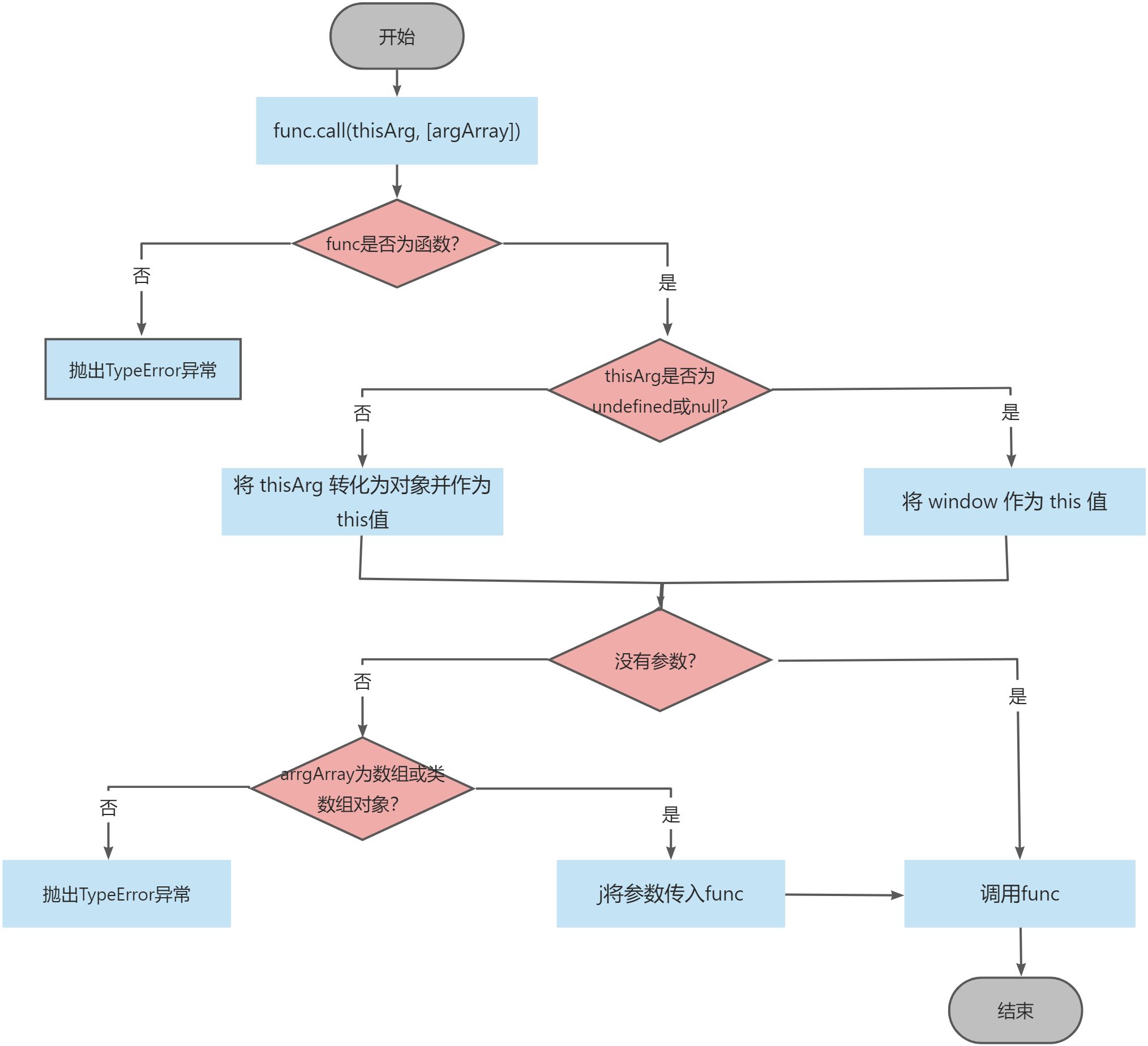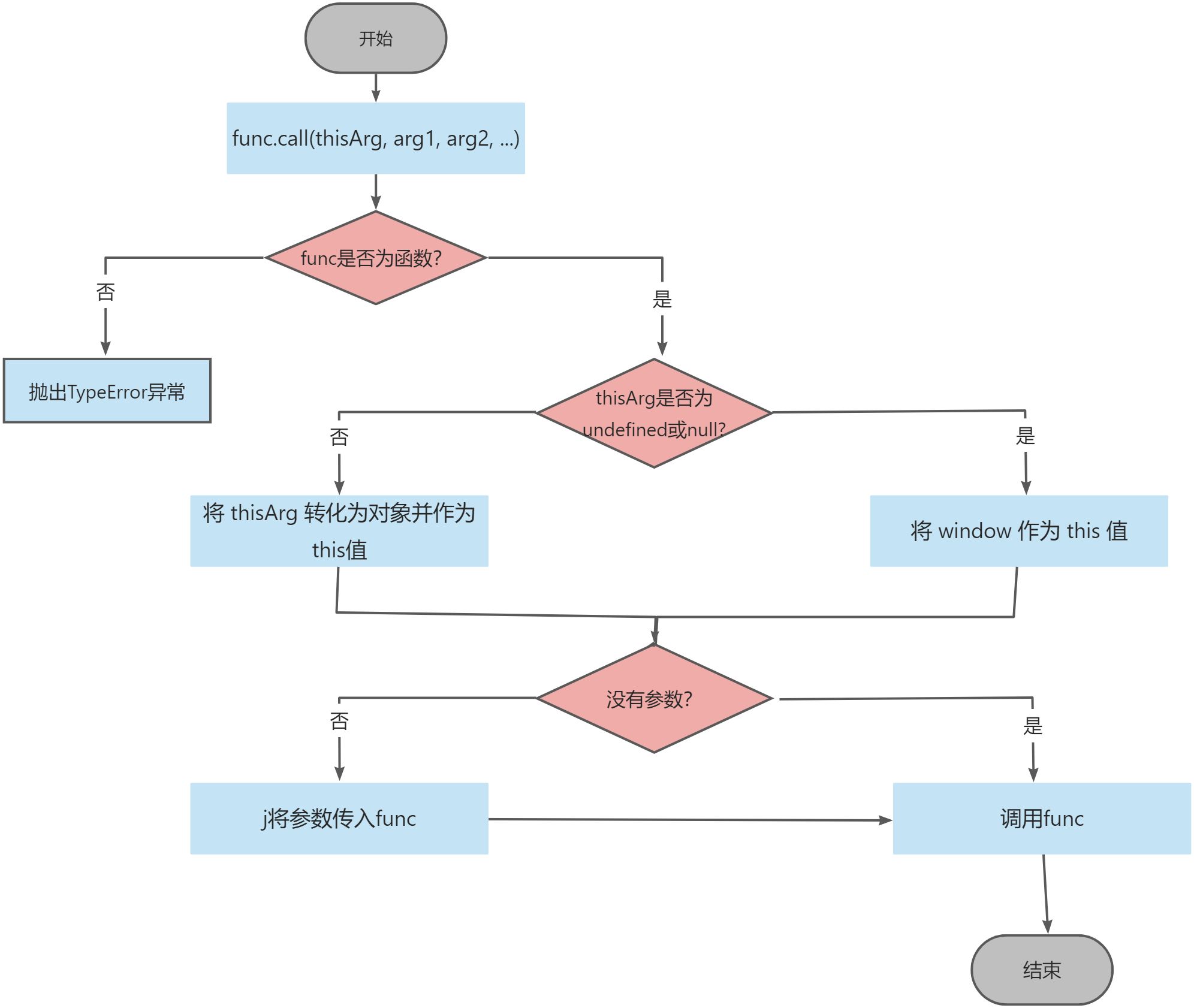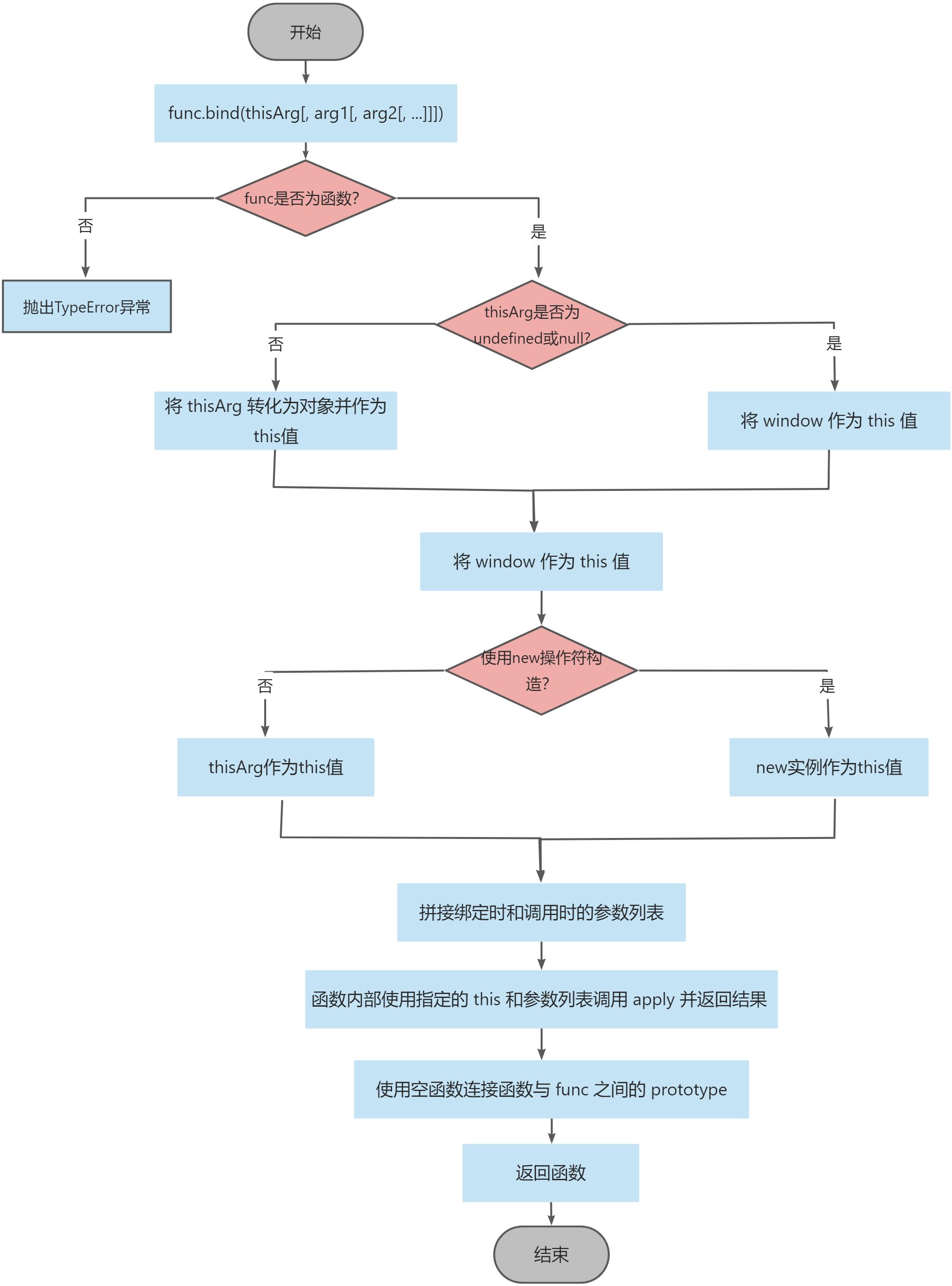在JavaScript中,经常会通过call / apply / bind 函数来改变this的指向,详情可看一文带你了解this指向,今天我们来研究下这三个函数的实现。
1. call
💡call()函数是什么?
**call()**方法使用一个指定的 this 值和单独给出的一个或多个参数来调用一个函数。也就是说**call()**改变了this指向并执行了函数。
1.1 语法
func.call(thisArg, arg1, arg2, ...)// thisArg为在 func 函数运行时使用的 this 值// arg1, arg2等为指定的参数列表// 其返回值为调用有指定 this 值和参数的函数的结果
1.2 流程图
一般来说,我们要模拟实现call,可以分为以下几个步骤:
1. .将函数设置为对象的属性, 当对象为null或undefined, 设为window对象2. 取出函数执行所需参数,执行该函数3. 如果函数存在返回值,在返回后删除该函数
1.3 代码实现
Function.prototype.call = function (thisArg, ...argsArray) {if (typeof this !== "function") {throw new TypeError("Function.prototype.call was called on which is not a function");}if (thisArg === undefined || thisArg === null) {thisArg = window;} else {thisArg = Object(thisArg);}// 将 func 放入 thisArg 内,这样在调用 thisArg[func] 时 this 自然就指向了 thisArgconst func = Symbol("func");thisArg[func] = this;let result;if (argsArray.length) {result = thisArg[func](...argsArray);} else {result = thisArg[func]();}delete thisArg[func];return result;};
2. apply
💡apply()函数是什么?
apply()方法调用一个具有给定 this 值的函数,以及以一个数组(或一个类数组对象)的形式提供的参数。同call()的功能,改变this指向的同时执行了函数。
2.1 语法
func.apply(thisArg, [argsArray]);// thisArg为在 func 函数运行时使用的 this 值// arg1, arg2等为指定的参数列表// 其返回值为调用有指定 this 值和参数的函数的结果
2.2 流程图
apply()方法实现的流程基本与call的实现流程没有太多差异,只需要对函数参数数组进行判断展开即可。
以下是apply()函数的流程图:
2.3 代码实现
Function.prototype.apply = function (thisArg, argsArray) {if (typeof this !== "function") {throw new TypeError("Function.prototype.apply was called on which is not a function");}if (thisArg === undefined || thisArg === null) {thisArg = window;} else {thisArg = Object(thisArg);}// 将 func 放入 thisArg 内,这样在调用 thisArg[func] 时 this 自然就指向了 thisArgconst func = Symbol("func");thisArg[func] = this;let result;if (argsArray && typeof argsArray === "object" && "length" in argsArray) {// 此处使用 Array.from 包裹让其支持形如 { length: 1, 0: 1 } 这样的类数组对象,直接对 argsArray 展开将会执行出错result = thisArg[func](...Array.from(argsArray));} else if (argsArray === undefined || argsArray === null) {result = thisArg[func]();} else {throw new TypeError("CreateListFromArrayLike called on non-object");}delete thisArg[func];return result;};
3. bind
💡bind() 函数是什么?
**bind()**方法创建一个新的函数,在bind() 被调用时,这个新函数的this被指定为 bind()的第一个参数,而其余参数将作为新函数的参数,供调用时使用。
3.1 语法
func.bind(thisArg[, arg1[, arg2[, ...]]])// thisArg 为调用绑定函数时作为 this 参数传递给目标函数的值, 如果使用 new 运算符构造绑定函数,忽略该值// arg1, arg2为当目标函数被调用时,被预置入绑定函数的参数列表中的参数。// 其返回值为一个原函数的拷贝,并拥有指定的 this 值和初始参数
3.2 流程图
想要实现bind函数,即需实现两个特点:一为返回一个函数;二为可以传入参数。所以我们可从以下几点入手:
1. 通过使用`call`或者`apply`实现 `this`的指定;2. 实现在`bind`的时候可以传参,在执行返回函数时传参;3. 判断是否使用 `new`操作符来确定`this`指向。
3.3 代码实现
Function.prototype.bind = function (thisArg, ...argsArray) {if (typeof this !== "function") {throw new TypeError("Function.prototype.bind was called on which is not a function");}if (thisArg === undefined || thisArg === null) {thisArg = window;} else {thisArg = Object(thisArg);}const func = this;const bound = function (...boundArgsArray) {let isNew = false;// 如果 func 不是构造器,直接使用 instanceof 将出错,所以需要用 try...catch 包裹try {isNew = this instanceof func;} catch (error) {}return func.apply(isNew ? this : thisArg, argsArray.concat(boundArgsArray));};const Empty = function () {};Empty.prototype = this.prototype;bound.prototype = new Empty();return bound;};
4.全文总结
call、apply与bind有什么区别?
- calll、apply 与 bind 都用于this绑定,但 call、apply 函数在改变this指向的同时还会执行函数;而 bind 函数在改变this后返回一个全新的绑定函数。
- bind 属于硬绑定,返回的绑定函数的this指向不能再通过 bind、apply 或 call 修改,即
this被永久绑定;call 与 apply 只适用于当前调用,一次调用后就结束。 - call 和 apply 功能完全相同,但call 从第二个参数后的所有参数都是原函数的参数;而 apply 只接受两个参数,第二个参数必须是数组,该数组包含着原函数的参数列表。



